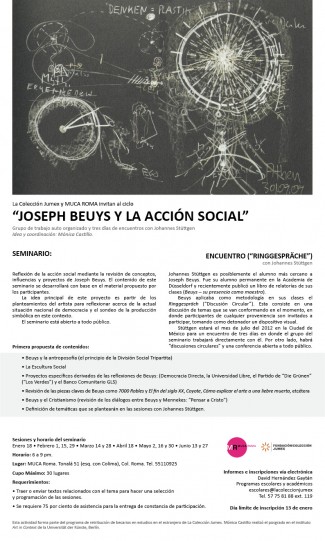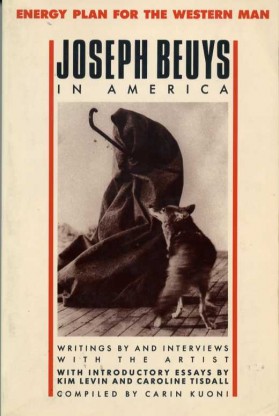Ayer empezó el ciclo Joseph Beuys y la acción social que imparte mi queridísima Mónica Castillo en el Muca Roma y rápidamente nos inscribimos Víctor y yo.
Me interesa porque seguramente van a participar muchos de los artistas jóvenes que están trabajando con cuestiones de arte, activismo, comunidad, etc., pero también porque veo relación entre el trabajo que desarrollaron mis maestras de artistas feministas (Suzanne Lacy y Leslie Labowitz) con el trabajo de Beuys, no tanto por el contenido, sino por la forma. Por ende, es una asignatura pendiente que tengo que cumplir para apuntalar teóricamente mi propio trabajo.
La sesión estuvo interesante, aunque de repente tediosa porque había muchas personas y a todas nos tocó decir cuál era nuestro interés en Beuys. La mayoría son artistas.
Llegando a la casa me puse a buscar la bibliografía que tenemos de Beuys.
Empiezo a leerlo y no me convence. Es confuso. Casi autoritario. En la página 21, en un texto llamado I am searching for field character de 1973 afirma:
"Only on condition of a radical widening of definition will it be possible for art and activities related to art to provide evidence that art is now the only evolutionary-revolutionary power. Only art is capable of dismantling the repressive effects of a senile social system that continues to totter along the deathline: to dismantle in order to build A SOCIAL ORGANISM AS A WORK OF ART".
Es mucha carga para el arte. Delirios de grandeza.
Pero poco después en la página 22 dice algo con lo que estoy completamente de acuerdo:
"Communication occurs in reciprocity: it must never be a one-way flow from the teacher to the taught. The teacher takes equally from the taught".
A veces me parece que el acto de leer es sólo confirmar en las palabras de otro lo que una piensa. Espero que me sorprenda y realmente me enseñe algo.
Un poco más adelante, en la página 75, en una entrevista con Kate Horsefield de 1980, dice lo siguiente:
"...I can only say that there are two kinds of art: the traditional art, which is unable to bring up art at all, or to change anything in society or the ability and the joy for life; and then, there is another kind of art, which is related to everybody's needs and the problems existing in society. This kind of art has to be worked out at the beginning it has to start from the molding power of the thought as a sculptural means. If this sculptural agent is not active in the beginning, it will never lead to result in any physical form; or the physical form will only be pollution for the world and will only enrich the whole rubbish of production we already have."
De entrada no estaría de acuerdo que el arte tradicional no puede cambiar nada en la sociedad. Tan ha podido afectar la sociedad que las religiones y las élites lo han utilizado para promover sus ideas. Sin embargo, me es claro que la mayoría de las obras, incluyendo las no tradicionales, no objetuales, alternativas, alógicas o como quiera llamárseles, no logran esa activación de la que habla y se convierten en contaminación. Es la pregunta de los $64,000.00: Cómo hacer obras o echar a andar procesos que sean significativos, eficaces, propositivo en lo político y lo artístico.
En la página 77, en una entrevista de 1969 con Willoughby Sharp, dice algo que me encanta:
"At the moment art is taught as a special field which demands the production of documents in the form of artworks. Whereas I advocate the aesthetic involvement from science, from economics, from politics, from religion – every sphere of human activity. Even the act of peeling a potato can be a work of art if it is a conscious act."
En ese sentido, si las obras artísticas tradicionales son documentación del proceso artístico, también son una forma válida de arte, el arte en el campo del arte. También me gusta lo de la pelada de la papa porque ese nivel de conciencia del acto común es lo clásico del performance, pero que horror vivir en ese nivel de autoobservación todo el tiempo.



